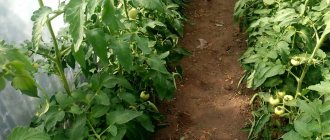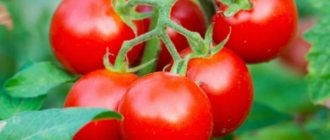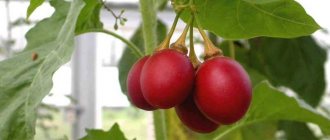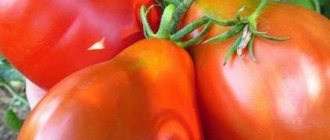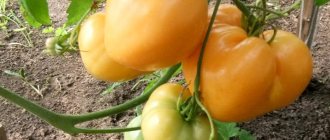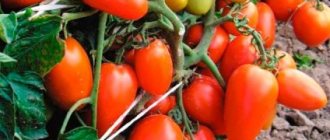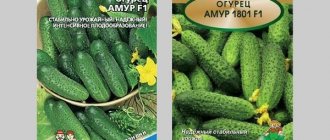Fragrant tomatoes from your own garden - what could be better for a farmer? For self-cultivation, hybrid varieties are best suited. They are ideally adapted for growing in certain climatic conditions, give a good harvest and do not get sick. Many gardeners love Raspberry Empire tomatoes for their fragrant fruits, good seedlings and a large number of tomatoes. What are the advantages and disadvantages of the variety, and how to grow this plant on your own plot?
Description of the variety
The tomato hybrid grows up to two meters in height and even higher. Given the intensive growth of tomatoes, they need to be bushed, neat shoots formed and excess removed. Experienced gardeners advise removing lower shoots and leaves and regularly treating a mature bush (once every week and a half). The plant heals and recovers best in sunny weather, so seedlings should be removed at this time. This way, pests will not be able to damage the stems, and the wounds will heal quickly.
Farmers appreciate that the aromatic fruits of the Raspberry Empire F1 tomatoes can be obtained both in the greenhouse and in open soil. In the second case, the harvest will be seasonal, but the greenhouse growing method will delight you with aromatic tomatoes even in the cold season.
Massive and tall bushes are grown only with a garter on a support or frame. In a greenhouse, these can be the supports of the structure itself; in an open area, strong pegs must be provided for tensioning the support threads and bushing.
During the growing season, tomatoes of this variety form ovaries. The inflorescence first appears above the seventh leaf, and then racemes form every couple of leaves. The fruit cluster itself consists of an average of four flowers, from which the ovaries and the fruits themselves are formed.
The developed root system is responsible for the “vitality” and strength of the plant. It pulls essential microelements and moisture from the soil. This feature of the Raspberry Empire hybrid must be taken into account when planting. Too high a density between plants will not allow them to develop normally and receive sufficient nutrients and moisture. On average, it is recommended to plant only a couple of bushes per square meter (sometimes three are possible, but it is better to maintain less density).
Harvesting
Active harvesting is carried out almost every day, usually in the summer, when tomatoes are actively bearing fruit. In summer, you need to carefully ensure that the greenhouse is ventilated if the air temperature reaches high levels. During other seasons, when the growth activity of tomatoes decreases somewhat, they are harvested 2-3 times a week.
Tomatoes are harvested in a greenhouse before the temperature drops below zero degrees. Failure to comply with this rule will expose the fruit to freezing. The appearance of pink ripeness on a tomato is a signal to harvest it. If you pick bright red tomatoes at full ripeness, then after picking the ripening of the bunch will be more intense and the fruits that grow on it will become smaller and lose their filling.
Appearance of fruits
What do tomatoes of this hybrid variety look like? Externally, the fruits are round, slightly flattened, and bright pink-red in color. The tomatoes are heavy, over 150 grams. Tomatoes are perfect for eating fresh - the fruits are juicy, aromatic and tasty. The pulp itself is dense and consists of two or more chambers. Despite the fact that the tomato skin is thin, it does not crack or get damaged - the hybrid variety is suitable for canning as a whole.
In the photo of Raspberry Empire F1 tomatoes you can perfectly evaluate the appearance of the fruit - take a look at it in the images below.
Gardeners unanimously claim that this variety makes excellent tomato pastes and preserves. Vegetables are also good in any culinary dishes, fresh or after heat treatment. But the thick pulp does not allow you to get a homogeneous juice - it is too dense and more like a mousse.
Characteristic
Raspberry Empire f1 is an early ripening hybrid, since you can enjoy ripe fruits at 95-110 days. From 1 m2 you can get 20 kg of tasty and ripe vegetables. The crop is grown mainly in a greenhouse, since in open ground the yield drops by 1/3.
Tomato has the following advantages:
- high productivity;
- strong immunity, thanks to which the plant resists many diseases;
- You can enjoy juicy tomatoes until the end of autumn if you grow them in an open area and in a greenhouse all year round;
- the fruits are characterized by rapid ripening;
- the harvested crop is subject to long-term storage;
- during transportation, the fruits do not crack and do not lose their presentation;
- vegetables have excellent taste and strong aroma.
The variety has its disadvantages:
- the need for constant formation of the bush in order to water the yield;
- it is necessary to regularly moisten the soil and apply fertilizing;
- Cultivation in open ground reduces yield;
- It’s impossible to get fresh juice from vegetables.
Average hybrid yield
Like most artificially bred varieties, “Raspberry Empire F1” is an early ripening variety. The first fruits can be collected within three months after planting the seeds for seedlings in special containers. This characteristic is a great advantage for residents of cold regions of the Russian Federation, because due to the short summer and frequent frosts it is quite difficult to get a good harvest of varietal tomatoes.
It is important to remember that tomatoes of this variety ripen “together”, that is, in clusters. This creates a lot of stress on the stems, and the plant bends to the ground, sometimes even breaks. Be sure to tie the stems to a support or twine to prevent crop loss.
Under favorable ripening conditions, more than twenty kilograms of good, selected tomatoes can be harvested from each square of soil. The yield of the hybrid when ripening in open soil is 30% less; greenhouse cultivation is much more effective.
Sowing seeds for seedlings
To grow seedlings, you need high-quality seeds from a trusted supplier.
Optimal timing
Seedlings are prepared 60–65 days before transplanting into a greenhouse or open bed. The exact sowing time depends on the region and the ability to use additional lighting. The average date is mid-March.
Soil mixture
A large selection of soil mixtures for growing seedlings is available in shopping and garden centers. If you decide to prepare the soil yourself, it is necessary to carry out preliminary disinfection of the soil collected in the garden or other place.
There are several ways to destroy possible sources of diseases and pests:
- pour in a solution of potassium permanganate;
- expose to water vapor for 7–8 minutes followed by cooling;
- leave for 30 minutes in the oven at +70°C–+90°C;
- freeze and let thaw (repeat the procedure 2-3 times). The temperature in the cold should be –15°C––20°C, and the ground should thaw within 3–5 days.
- a teaspoon of urea;
- a tablespoon of potassium sulfate;
- three tablespoons of superphosphate.
Growing container
The optimal container for seedlings is ready-made plastic or peat containers with a transparent lid that will not touch the ground. Such a shelter will provide a greenhouse microclimate favorable for seed germination. If there is no lid, you can use glass or film.
Seed preparation
The first rejection consists of inspecting the seed and removing damaged seeds. Further:
- soak in a weak solution of potassium permanganate. Seeds that have sunk to the bottom are tested for germination;
- Soak selected seeds in “Epin-extra”, “Zircon” or “Kornevin”, which are modern growth stimulants.
Chamomile - medicinal properties and contraindications (Chamomilla officinalis)
Sowing seeds
Sowing is carried out according to the standard scheme to a depth of 1–1.5 cm. The first watering with warm water is done from a spray bottle to avoid washing out the seed with a stream of water. Then you need to close the container with a lid and put it in a warm place.
The tomato germinates in 7-10 days. Until this point, the lid is opened only to spray dried soil. If condensation appears on the walls, it must be removed.
Seedling care
Sprouted tomatoes are placed in a well-lit place at a temperature of +15°C–+16°C, and then it is raised again to room temperature.
For healthy seedlings it is necessary to provide:
- careful watering by spraying warm water under the roots;
- no waterlogging;
- good lighting.
Fertilizing of seedlings is carried out in case of obvious lack of nutrients, which can be judged by the appearance of the plants:
- lack of potassium is manifested by leaf wrinkling;
- lack of phosphorus is visible by purple veins on the stems and lower parts of the leaves;
- yellowing and falling of the lower leaves is a signal of nitrogen deficiency.
Hardening of seedlings
To prevent the seedlings from being subjected to too much stress in their permanent location, they begin to prepare them for new conditions in advance. The hardening process begins 7–10 days before transplantation.
The plants are taken out into the open air, first for half an hour, and then the time is increased to full daylight. It is necessary to monitor the temperature: the minimum mark for tomatoes is +8°C. The place chosen for the procedure should not be in a draft and should not be illuminated by direct rays of the sun. For hardening at home, you can use a balcony with open windows.
Pest protection
Gardeners know that tomatoes are easy to lose due to fungus, viral or bacterial pests. However, during selection, hybrids change at the genetic level, become resistant to the adverse effects of the external environment and do not rot. “Crimson Empire F1” is weakly resistant only to late blight. But with the help of special treatment of the plant, the disease can be prevented almost 100%.
When growing this hybrid, you should avoid excessive watering and humidity; you should not plant tomatoes on a damp and rainy day. The best time to trim excess is a sunny day and warm, dry weather. Pre-treatment against insect pests will also help protect the crop.
Advantages and disadvantages of a hybrid
Why is it worth choosing “Raspberry Empire F1” tomatoes for growing on your plot, and who are these tomatoes not suitable for?
The advantages of the variety include:
- High levels of taste, aromatic fruits.
- Relatively high yield in any environment - in the greenhouse and in open soil.
- Immune to most diseases typical of varietal tomatoes.
- If you have a greenhouse, “Raspberry Empire F1” will always be fresh on the table.
- Early harvest time - up to three months from the moment of planting the seedlings.
But even such a universal hybrid has its own characteristics. These include:
- Some difficulties in bushing a tall plant (constant pinching and bush formation are required).
- Tomatoes grow well only in nutritious soil with good watering and care.
- "Crimson Empire F1" will not grow in the cold soil of the northern regions of Russia.
- Dense pulp does not allow you to get good tomato juice.
All these features of the variety cannot be called disadvantages. An experienced farmer will cope with the difficulties of care and get a good harvest of selected Raspberry Empire tomatoes.
Main characteristics of the line
The raspberry miracle is classified into 3 series of 5 varieties. Tomatoes are grown both in open ground and in greenhouse conditions. They are actively used by vegetable growers and consumers for freshly prepared dishes and preservation.
General characteristics for all varieties of the line:
- weight of tomatoes – 100-500 g;
- fleshy core;
- some seeds in the middle;
- the peel is smooth and even;
- moderate ribbing;
- dry matter in high concentration.
These varieties are united by a deep crimson hue and high yield even with sudden changes in temperature and insufficient watering. The largest tomatoes appear where the lower leaves are located, medium and small fruits - in the upper part of the plant.
Productivity and fruiting
If you follow the rules for growing the Raspberry miracle, you can harvest a good harvest every summer. During the season (90-100 days) you can collect 5-10 kg of fruits from one bush. This indicator is not significantly affected by weather conditions, including a sharp drop in air temperature.
The fruits weigh 100-500 g each, depending on the selected variety. The skin is dense and does not crack. A vegetable grower can safely count on a rich harvest; the main thing is to increase watering during the fruiting period.
Area of application of fruits
Tomatoes are used fresh and processed. Thanks to their thick skin, they are stored in the refrigerator for a long time and become a useful ingredient in salads. Raspberry miracle is used for preservation: small fruits are rolled up whole or processed to produce juice, paste, vegetable salad, dressings for first courses and sauces.
Vegetable growers use this variety for personal consumption and put it up for sale. This is explained by the high yield: it’s enough for a family to eat the Raspberry Miracle and make a profit.
Resistance to diseases and pests
Raspberry miracle is immune to late blight (fungi) and has good immunity. But this does not mean that, like other plants, they do not need prevention. It is better to stock up on special anti-fungal products in advance to protect the tomato bushes and the entire garden as a whole.
To avoid infection, it is advisable to remove the lower leaves of tomatoes, promptly remove weeds from the area, and regularly loosen the soil to enrich it with oxygen. You cannot plant Raspberry Miracle in areas where potatoes, bell peppers, and eggplants previously grew.
Basic growing rules
Knowing some of the characteristics of the variety, it is not difficult to grow these tomatoes. They produce a good harvest from seedlings. After sowing the seeds in a special container, they can be planted in open soil within two months. For most regions of Russia, this is from the second half of May for greenhouses. You can start preparing seedlings as early as March (from the 15th).
To plant in the soil, the seedlings must be strong, with formed green leaves. The average height of the stem before planting is 22 cm. It is better to first feed the soil with organic fertilizers or humus. After planting, the soil can be mulched with straw or peat. Regular fertilization and watering will ensure an excellent harvest.
These tomatoes ripen better in a greenhouse. There it is possible to maintain the required air humidity and temperature. “Raspberry Empire F1” grows well at +24°C and 60% humidity around the clock. A stable microclimate is the key to the growth of good, selected tomatoes without diseases.
But by choosing good and high-quality seeds, you can grow fragrant fruits in open soil. Agro offers only high-quality tomato seed for cultivation throughout Russia. Tested seeds are a guarantee of harvest quality.
How to care
Caring for the “raspberry empire” hybrid consists of regular watering, bush formation and fertilizing. In a greenhouse, tomatoes grow well at +24°C and 60% humidity.
Watering
Watering is carried out as the soil dries with settled water, trying not to get on the foliage. To reduce the rate of soil drying, mulching with hay and other mixtures is used. Drip irrigation is recommended.
Feeding
For a high yield, it is necessary to fertilize the bushes every 10 days.
A proven fertilizer recipe consists of the following ingredients:
- a bucket of solution (1 part mullein to 5 parts water);
- 10 g ammonium nitrate;
- 50 g superphosphate;
- 15 g potassium salt.
Stepsoning
The bushes need constant pinching, that is, the removal of new shoots in the internodes of the leaves. Breaking out shoots should be done as early as possible and in sunny weather to avoid infection of the wound with diseases. The bush is formed into 1–2 stems.
Soil care
Plants need nutritious and loose soil, as well as the absence of weeds.
The best way to solve these problems is to completely mulch the bushes. Can be used:
- dry hay;
- a mixture of sawdust and compost;
- humus.
The mulch is laid out immediately after planting
Important! Pine bark and freshly cut grass cannot be used for mulching. Cardboard and printed newspapers are also not used. Mulching will not only protect the plant from drought and overheating, but will also speed up ripening and protect fruits from contamination.
Mulching will not only protect the plant from drought and overheating, but will also speed up ripening and protect fruits from contamination.
Tying up a bush
Tall bushes with heavy tassels need reliable support and tying, since the stem can easily break under the weight of the fruit. The trellis is built in open ground, and sometimes the frame of the structure itself is used in a greenhouse. For tying, special materials or soft tape are used so as not to damage the stem.
Preventative treatment
This hybrid is resistant to most diseases, except late blight. To prevent the disease, it is necessary to treat with branded copper preparations or iodine solutions.
Important! To avoid possible infection, all formation activities are first carried out with strong and healthy bushes, and then move on to weaker ones. To protect plants from tomato pests, special insecticides and folk remedies are used, including spraying with herbal mixtures and ash solutions, as well as modern immunostimulants and biological products
Video: Tomato variety “Raspberry Empire”, yield
The “raspberry empire” hybrid has good economic prospects, especially in closed ground conditions. Plants respond to proper care with high yields.


